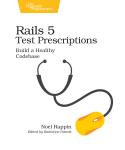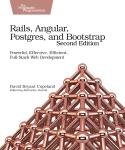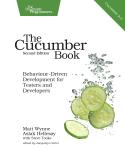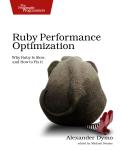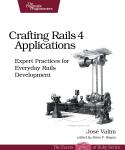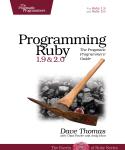About This Title
Pages: 494
Published: February 2020
ISBN: 9781680506709
In Print

Agile Web Development with Rails 6
by Sam Ruby and David Bryant Copeland
Learn Rails the way the Rails core team recommends it, along with the tens of thousands of developers who have used this broad, far-reaching tutorial and reference. If you’re new to Rails, you’ll get step-by-step guidance. If you’re an experienced developer, get the comprehensive, insider information you need for the latest version of Ruby on Rails. The new edition of this award-winning classic is completely updated for Rails 6 and Ruby 2.6, with information on processing email with Action Mailbox and managing rich text with Action Text.
STOP
This edition covers Rails 6.
The edition covering Rails 7 is available here: Rails 7
The edition covering Rails 5.1 is available here: Rails 51
The edition covering Rails 4 is available here: Rails 4
PLEASE MAKE SURE YOU’RE BUYING THE RIGHT EDITION.
Ruby on Rails 6 Video Course by Mike Clark and Nicole Clark
At times Rails can feel magical. That’s part of what makes it so productive and powerful. But until you understand the “magic”, trying to build a Rails app can be just plain frustrating!
How much more satisfying would it be to pop open your code editor next week and confidently jump into a Rails app? Build a new feature you can be proud of. Laugh in the face of error messages because you know how to fix them. Heck, even deploy your app.
You can do this. The “magic” of Rails is totally understandable. For 16 years The Pragmatic Studio has been helping developers move from confusion to confidence with Rails. One concept at a time. One clear explanation at a time. One “AHA!” moment at a time.
In their online video course you build not just one, but two full-featured Rails apps from start to finish. You see every move, every change, every refactoring first hand. It’s a finely-tuned mix of videos, animations, and exercises that have demystified Rails for thousands of developers. In no time you’ll go from “Argh, I’m lost!” to “Aha, now I TOTALLY get it!”
Buy directly from The Pragmatic Studio.
eBook Formats:
PDF for desktop/tablets
epub for Apple Books, e-readers
mobi for Kindle readers
Get all eBook formats here for $29.95 (USD)
Paperback Formats:
Order via Bookshop (U.S. Only)
Please support indie bookstores!
Find indie bookstores in the U.S. Find indie bookstores around the world.
Ruby on Rails helps you produce high-quality, beautiful-looking web applications quickly—you concentrate on creating the application, and Rails takes care of the details. Rails 6 brings many improvements, and this edition is updated to cover the new features and changes in best practices.
We start with a step-by-step walkthrough of building a real application, and in-depth chapters look at the built-in Rails features. Follow along with an extended tutorial as you write a web-based store application. Eliminate tedious configuration and housekeeping, seamlessly incorporate Ajax and JavaScript, send and receive emails, manage background jobs with ActiveJob, and build real-time features using WebSockets and ActionCable. Test your applications as you write them using the built-in unit, integration, and system testing frameworks, internationalize your applications, and deploy your applications easily and securely. New in this edition is coverage of Action Mailbox, which allows you to receive emails in your app, as well as Action Text, a zero-configuration rich text editing feature.
Rails 1.0 was released in December 2005. This book was there from the start, and didn’t just evolve alongside Rails, it evolved with Rails. It has been developed in consultation with the Rails core team. In fact, Rails itself is tested against the code in this book.
What You Need
All you need is a Windows, Mac OS X, or Linux machine to do development on. This book will take you through the steps to install Rails and its dependencies. If you aren’t familiar with the Ruby programming language, this book contains a chapter that covers the basics necessary to understand the material in the book.Resources
Releases:
Contents & Extracts
- Getting Started
- Installing Rails
- Installing on Windows
- Installing on macOS
- Installing on Linux
- Choosing a Rails Version
- Setting Up Your Development Environment
- Rails and Databases
- Instant Gratification
- Creating a New Application
- Hello, Rails!
excerpt

- Linking Pages Together
- When Things Go Wrong
- The Architecture of Rails Applications
- Models, Views, and Controllers
- Rails Model Support
- Action Pack: The View and Controller
- Introduction to Ruby
- Ruby Is an Object-Oriented Language
- Data Types
- Logic
- Organizing Structures
- Marshaling Objects
- Pulling It All Together
- Ruby Idioms
- Installing Rails
- Building an Application
- The Depot Application
- Incremental Development
- What Depot Does
- Let’s Code
- Task A: Creating the Application
- Iteration A1: Creating the Product Maintenance Application
- Iteration A2: Making Prettier Listings
- Task B: Validation and Unit Testing
- Iteration B1: Validating!
- Iteration B2: Unit Testing of Models
- Task C: Catalog Display
- Iteration C1: Creating the Catalog Listing
- Iteration C2: Adding a Page Layout
- Iteration C3: Using a Helper to Format the Price
- Iteration C4: Functional Testing of Controllers
- Iteration C5: Caching of Partial Results
- What We Just Did
- Task D: Cart Creation
- Iteration D1: Finding a Cart
- Iteration D2: Connecting Products to Carts
- Iteration D3: Adding a Button
- Task E: A Smarter Cart
- Iteration E1: Creating a Smarter Cart
- Iteration E2: Handling Errors
- Iteration E3: Finishing the Cart
- Task F: Add a Dash of Ajax
- Iteration F1: Moving the Cart
- Iteration F2: Creating an Ajax-Based Cart
- Iteration F3: Highlighting Changes
- Iteration F4: Hiding an Empty Cart with a Custom Helper
- Iteration F5: Broadcasting Updates with Action Cable
- Task G: Check Out!
- Iteration G1: Capturing an Order
- Iteration G2: Atom Feeds
- Task H: Entering Additional Payment Details
excerpt

- Iteration H1: Adding Fields Dynamically to a Form
- Iteration H2: Testing Our JavaScript Functionality
- Task I: Sending Emails and Processing Payments Efficiently
- Iteration I1: Sending Confirmation Emails
- Iteration I2: Connecting to a Slow Payment Processor with Active Job
- Task J: Logging In
- Iteration J1: Adding Users
- Iteration J2: Authenticating Users
- Iteration J3: Limiting Access
- Iteration J4: Adding a Sidebar, More Administration
- Task K: Internationalization
- Iteration K1: Selecting the Locale
- Iteration K2: Translating the Storefront
- Iteration K3: Translating Checkout
- Iteration K4: Adding a Locale Switcher
- Task L: Receive Emails and Respond with Rich Text
- Iteration L1: Receiving Support Emails with Action Mailbox
- Iteration L2: Storing Support Requests from Our Mailbox
- Iteration L3: Responding with Rich Text
- The Depot Application
- Rails in Depth
- Finding Your Way Around Rails
excerpt

- Where Things Go
- Naming Conventions
- Active Record
- Defining Your Data
- Locating and Traversing Records
- Creating, Reading, Updating, and Deleting (CRUD)
- Participating in the Monitoring Process
- Transactions
- Action Dispatch and Action Controller
- Dispatching Requests to Controllers
- Processing of Requests
- Objects and Operations That Span Requests
- Action View
- Using Templates
- Generating Forms
- Processing Forms
- Uploading Files to Rails Applications
- Using Helpers
- Reducing Maintenance with Layouts and Partials
- Migrations
- Creating and Running Migrations
- Anatomy of a Migration
- Managing Tables
- Advanced Migrations
- When Migrations Go Bad
- Schema Manipulation Outside Migrations
- Customizing and Extending Rails
- Testing with RSpec
- Creating HTML Templates with Slim
- Serving CSS via Webpack
- Customizing Rails in Other Ways
- Where to Go from Here
- Finding Your Way Around Rails
excerpt
Author
Sam Ruby is president of the Apache Software Foundation, previously co-chaired the W3C HTML Working Group, and has made significant contributions to many open source projects and standards.
David Bryant Copeland has been a professional programmer since 1995. He’s the author of Build Awesome Command-Line Applications in Ruby 2 and Rails, Angular, Postgres, and Bootstrap. He has worked at LivingSocial and Opower, and is the Chief Software Architect at Stitch Fix.
Dave Thomas, as one of the authors of the Agile Manifesto, understands agility. As the author of Programming Ruby, he understands Ruby. And, as an active Rails developer, he knows Rails.
eBook Formats:
PDF for desktop/tablets
epub for Apple Books, e-readers
mobi for Kindle readers
Get all eBook formats here for $29.95 (USD)
Paperback Formats:
Order via Bookshop (U.S. Only)
Please support indie bookstores!
Find indie bookstores in the U.S. Find indie bookstores around the world.
Related Titles:

About This Title
Pages: 494
Published: February 2020
ISBN: 9781680506709
Edition: 1
In Print



